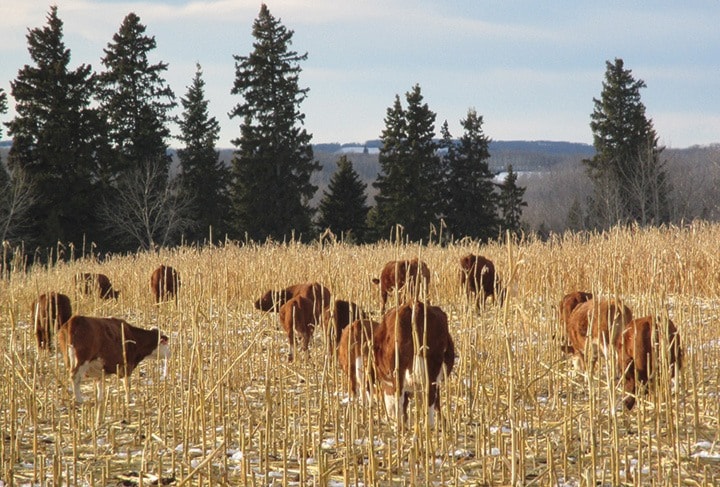With the strange weather that ended harvest operations in Alberta early last fall, cattle producers are turning to grazing herds in standing corn instead of feeding it as silage.
And that has Alberta Agriculture and Forestry (AF) urging producers to take some precautions in order to avoid potential problems.
Barry Yaremcio, a beef and forage specialist with AF, explained the weather has conditions favourable for mould.
“With the weather, a lot of the soluble sugars has been released out of the cellular structure and made available to different microbes and bacteria that produce moulds and mycotoxins,” he said.
“High humidity, frequent rainfall and frosts have created ideal conditions for moulds to form. Saprophytic moulds that cause deterioration are noticeable on the leaves and husks. This reduces feed quality especially the amounts of energy and protein left in the forage.”
The mycotoxins found in many samples so far this winter include T-2, HT-2 and DON, which produce an irritation in the mouth that causes animals to reduce what they eat. Yaremcio stated there is usually no problem with standing corn as the cattle will eat the cob then the tassels and finally the leaves. However, problems come when the cattle leave the higher energy and protein filled cobs on the stalks.
“If you go out and see the leaves are gone and the cobs untouched, it’s a big red flag,” he stated.
According to Yaremcio, the first thing is to get the plants tested followed by supplementing with a grain and protein mix made up of four to five pounds of grain with one to 1.5 pounds of a 32 per cent protein supplement or 2.5 pounds of peas. Another option to make up protein is a molasses lick at either 32 or 20 per cent, making certain the cattle consumer about three to four pounds each day to meet energy requirements.
Ensuring the cattle receive that on a daily basis will maintain their energy and fat levels, but without it the cattle could lose as much as two pounds a day.
“You need to watch them because when cows don’t consume enough energy, the fat will be mobilized to make up the shortfall,” he said.
“This will negatively impact the animals’ ability to withstand cold, windy conditions, reduce colostrum and milk production and could increase calving difficulties. With any of these options, you will need to evaluate them and any associated costs.”
He added a 50 per cent daily ration of high quality alfalfa grass hay or silage are other options, though farmers are urged to consult with a nutritionist to develop a feeding program that works best for the situation.
Producers should also be on the lookout for blocky mature or cows appearing full, sure signs of possible mycotoxins in the feed.
In addition, keeping that standing crop separate from being mixed with other feed will mean the cows can be selective about what they eat, not making them consume the toxins and compounding any problems.
For information about having crops tested or about feeding corn to cattle, get in touch with the experts at the Alberta Ag-Info Centre by calling 310-FARM (3276).
